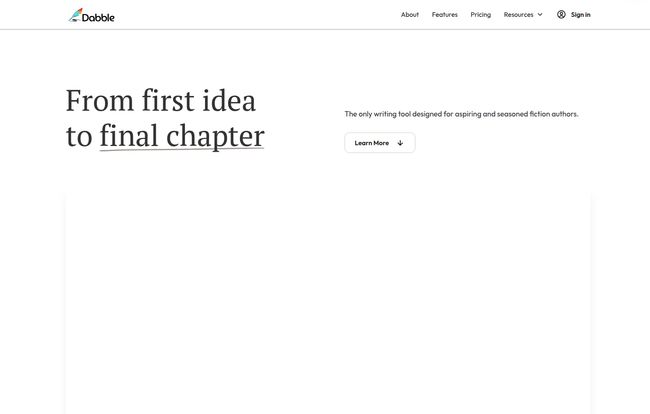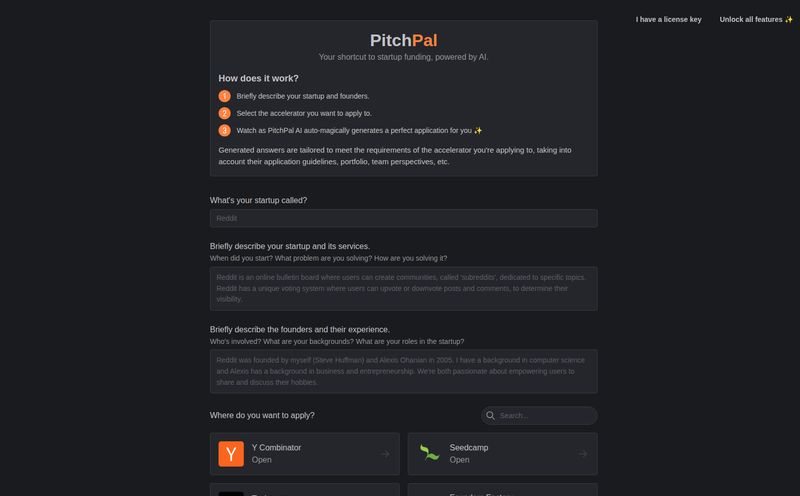Ah, the eternal quest. The writer's favorite form of productive procrastination: hunting for the perfect piece of writing software. We've all been there. You spend more time setting up your digital workspace than actually, you know, writing in it. I've personally run the gauntlet—from the stark, unforgiving void of Microsoft Word, through the collaborative chaos of Google Docs, and deep into the labyrinthine corridors of Scrivener.
Each has its place, sure. But none of them ever felt quite right for the messy, sprawling, beautiful process of building a novel from the ground up. Word is for memos. Google Docs is for sharing. Scrivener is... well, Scrivener is incredibly powerful, but I swear you need a PhD to use it to its full potential. The learning curve is a cliff face.
So when a tool like Dabble pops onto my radar, promising “Fiction without the friction,” my ears perk up. It claims to be intuitive, built specifically for novelists, and designed to get out of your way. But does it live up to the hype? I took it for a spin. Let’s get into it.
What Exactly is Dabble Writer?
At its core, Dabble is a web-based writing application designed for long-form fiction. Think of it less like a word processor and more like a dedicated project manager for your story. While other programs try to be a jack-of-all-trades, Dabble focuses on the specific needs of a novelist: plotting, organizing scenes, tracking character arcs, and of course, getting the words down on the page.
The whole philosophy seems to be about removing barriers. Instead of a million buttons and menus, you get a clean, focused interface. It’s a breath of fresh air, honestly. It feels like it was designed by writers who were just as fed up with the existing options as the rest of us.
The Core Features That Actually Matter to a Writer
A fancy feature list is one thing, but how does it perform in the trenches? When you're 50,000 words deep and can't remember if your sidekick's eyes are blue or green, does the tool help or hinder? Here’s what stood out to me.
The Plot Grid - Your Story's Blueprint
This is, for my money, one of Dabble's killer features, especially if you're a plotter. The Plot Grid is essentially a digital version of a corkboard with index cards. You can create plot lines (for your main plot, subplots, character arcs, etc.) and then map out scenes for each one. It gives you this incredible bird's-eye view of your entire story structure.
I’ve tried doing this with spreadsheets and it's just...clunky. Dabble makes it visual and interactive. You can see where your pacing might be lagging or where a subplot gets dropped. For someone who likes to have a roadmap before they start driving, this is an absolute game-changer.

Visit Dabble
A Writing Environment That Gets Out of Your Way
Once you’re ready to write, Dabble does a fantastic job of disappearing. The writing screen is clean, minimalist, and has a great Focus Mode that fades out everything but your current paragraph. And yes, it has a Dark Mode, because what writer doesn't secretly live like a vampire? It's these little touches that show they understand the writing process.
They also have integrated Goals and Stats. You can set daily word count goals or a total manuscript target. This is pure gold during something like NaNoWriMo or just for keeping yourself honest on a slow Tuesday. Seeing that little progress bar inch forward is a surprisingly powerful motivator.
Organization Without the Overwhelm
Remember that folder on your desktop? The one with 'Character_Notes.docx', 'Plot_Ideas_v2.txt', 'Chapter1_draft3_final.docx'? Dabble aims to kill that folder. It keeps all your manuscript chapters, scenes, and story notes in one tidy, navigable space. You can have notes for characters, settings, and anything else right alongside your manuscript. No more frantic alt-tabbing to find a piece of information. It’s all there, one click away. It's not as insanely detailed as Scrivener's binder, but that's the point. It's organization that serves the writer, not the other way around.
Dabble vs. The Usual Suspects
Okay, so how does it stack up against the big guys? It's not about which is objectively 'best', but which is best for you.
My take? Dabble feels like the perfect middle ground. It's the well-organized workbench with your favorite tools within arm's reach. Scrivener is the giant warehouse where the tool you need is somewhere in an unlabeled crate. And Word? Word is a beautiful, empty table. Great for serving the finished meal, but not for cooking it.
| Feature | Dabble | Scrivener | Google Docs / Word |
|---|---|---|---|
| Ease of Use | Very High | Low (Steep curve) | High |
| Plotting Tools | Excellent (Plot Grid) | Good (Corkboard) | None (DIY) |
| Cloud Sync | Native & Automatic | Manual (via Dropbox, etc.) | Native & Automatic |
| Best For | Streamlined novel writing | Complex research/academic projects | Sharing & final formatting |
Let's Talk Money - Dabble's Pricing Explained
This is often the sticking point. Dabble is a subscription service, which I know will make some writers groan. Here’s the breakdown:
- Basic ($9/month): This gets you in the door. You get the core writing tools, unlimited manuscripts, and cloud sync. It's enough to get started, but you miss out on the good stuff.
- Standard ($19/month): This feels like the real deal. It adds the Plot Grid, story notes, focus mode, and comments. In my opinion, this is the tier where Dabble really starts to shine and the one most serious writers should consider.
- Premium ($29/month): For those getting ready to publish or collaborating. This adds advanced grammar checks (powered by ProWritingAid), co-authoring, and access to workshops. It's a hefty price, but the features could be worth it for a specific type of user.
- Lifetime Access ($699): A one-time payment for all Premium features, forever. It's a big upfront cost, but if you do the math, it pays for itself in about two years compared to the Premium monthly plan. If you try Dabble and fall in love, this is a very attractive option to escape the subscription cycle.
The Little Things I Actually Liked (And a Few Niggles)
What really sold me were the small quality-of-life wins. The automatic cloud sync and backup is a genuine relief. I've lost work before, we all have. Knowing that my manuscript is safe without me having to think about it is worth a lot. The multi-device access is also fantastic—being able to jot down a quick idea on my phone and have it waiting on my laptop later is how things should work in 2024.
But it's not perfect. Nothing is. The subscription model is a definite con for writers on a shoestring budget. While there is an offline mode, it's primarily a cloud-based tool, so a stable internet connection is pretty important. And gating the Plot Grid—arguably its most compelling feature—behind the Standard plan feels a bit cheeky. I'd love to see that available on teh Basic tier to really hook new users.
So, Should You Switch to Dabble?
Here's my final verdict. Dabble is an exceptional tool for a specific kind of writer.
You should absolutely give Dabble a try if:
- You're a novelist who feels overwhelmed by Scrivener's complexity.
- You value a clean, distraction-free writing space.
- You are a plotter and the idea of a visual Plot Grid makes your heart sing.
- You write across multiple devices and need seamless syncing.
You might want to stick with your current setup if:
- You are philosophically opposed to subscription software.
- You write short stories or non-fiction that doesn't require deep structural organization.
- Your internet connection is unreliable at best.
The Final Word
Dabble has successfully carved out a space for itself between the simplicity of Google Docs and the complexity of Scrivener. It strikes a fantastic balance, offering powerful organizational tools without a punishing learning curve. It feels modern, thoughtful, and built with a writer's sanity in mind.
Don't just take my word for it. They offer a 14-day free trial, no credit card required. Give it a spin for your next project. What have you got to lose, besides that chaotic folder of half-finished drafts?
Frequently Asked Questions about Dabble
- Can I use Dabble offline?
- Yes! Dabble works offline. You can write and edit your work without an internet connection, and it will automatically sync everything to the cloud the next time you connect.
- Is Dabble better than Scrivener?
- It's not about 'better', it's about 'better for you'. Dabble is much easier to learn and use, with a focus on simplicity and cloud sync. Scrivener is more powerful, with more features for research and formatting, but comes with a significant learning curve.
- Can I import my existing novel into Dabble?
- Yes, you can. Dabble allows you to import from Word documents (.docx), making it fairly straightforward to move your existing projects over.
- Is the Dabble Lifetime deal worth the price?
- If you plan on using Dabble as your primary writing software for the long haul, then yes. It costs about the same as 24 months of the Premium subscription. If you're a career writer and you love the platform, it's a good investment to avoid monthly fees forever.
- Does Dabble have a free trial?
- Yes, Dabble offers a 14-day free trial of its Premium features. You don't need to enter a credit card to get started, so it's completely risk-free to try out.
Reference and Sources
- Dabble Official Website
- Dabble Pricing Information
- National Novel Writing Month (NaNoWriMo) - A great place to put writing tools to the test.



